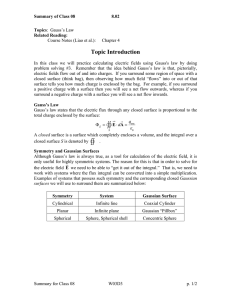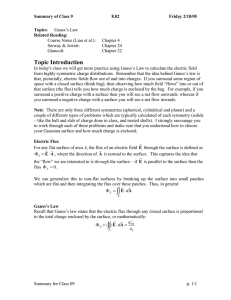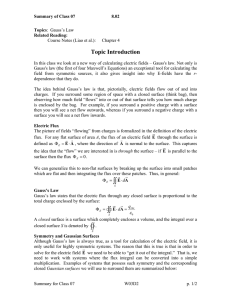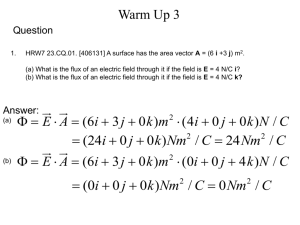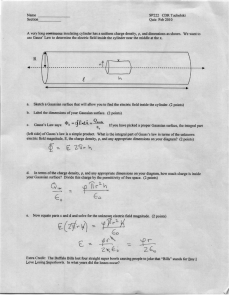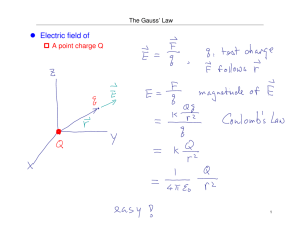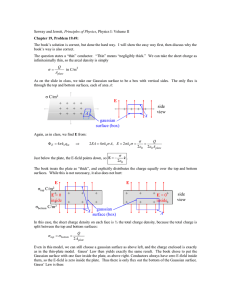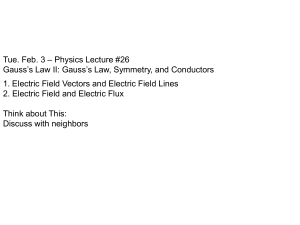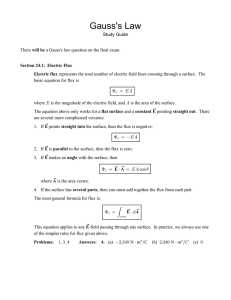Topic Introduction
advertisement
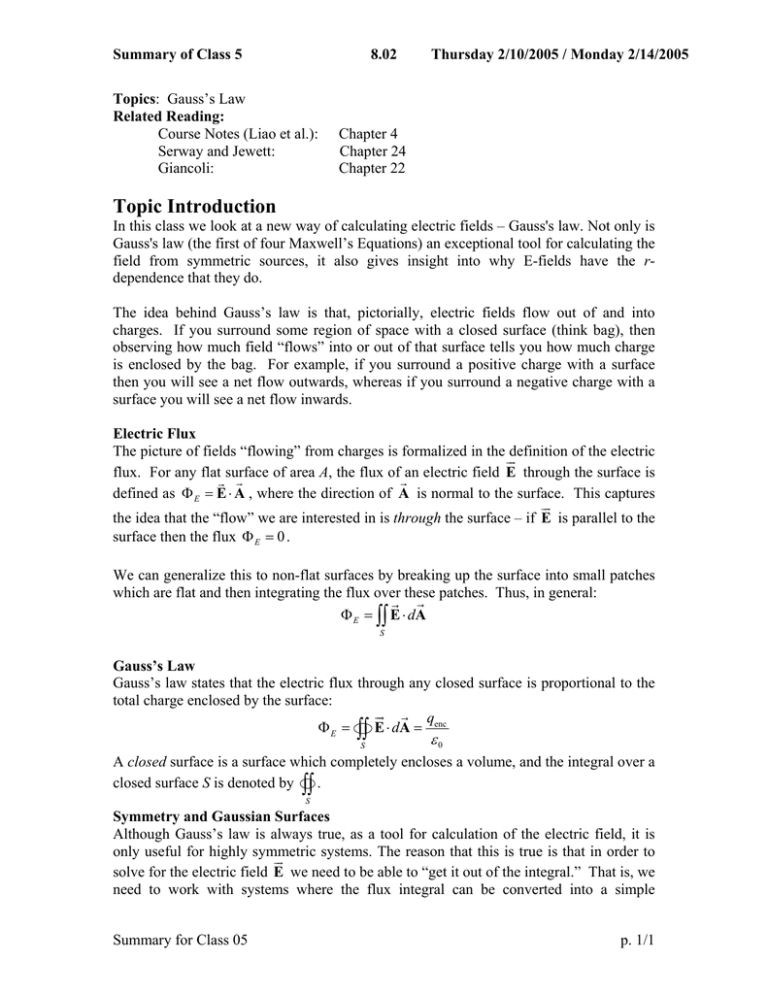
Summary of Class 5 8.02 Topics: Gauss’s Law Related Reading: Course Notes (Liao et al.): Serway and Jewett: Giancoli: Thursday 2/10/2005 / Monday 2/14/2005 Chapter 4 Chapter 24 Chapter 22 Topic Introduction In this class we look at a new way of calculating electric fields – Gauss's law. Not only is Gauss's law (the first of four Maxwell’s Equations) an exceptional tool for calculating the field from symmetric sources, it also gives insight into why E-fields have the rdependence that they do. The idea behind Gauss’s law is that, pictorially, electric fields flow out of and into charges. If you surround some region of space with a closed surface (think bag), then observing how much field “flows” into or out of that surface tells you how much charge is enclosed by the bag. For example, if you surround a positive charge with a surface then you will see a net flow outwards, whereas if you surround a negative charge with a surface you will see a net flow inwards. Electric Flux The picture of fields “flowing” from charges is formalized in the Jdefinition of the electric G flux. For any flat surface of area A, the flux of an electric field E through the surface is G G G defined as Φ E = E ⋅ A , where the direction of A is normal to the surface. This captures JG the idea that the “flow” we are interested in is through the surface – if E is parallel to the surface then the flux Φ E = 0 . We can generalize this to non-flat surfaces by breaking up the surface into small patches which are flat and then integrating the flux over these patches. Thus, in general: G G Φ E = ∫∫ E ⋅ dA S Gauss’s Law Gauss’s law states that the electric flux through any closed surface is proportional to the total charge enclosed by the surface: JG G q ΦE = w E ∫∫ ⋅ dA = enc S ε0 A closed surface is a surface which completely encloses a volume, and the integral over a closed surface S is denoted by w ∫∫ . S Symmetry and Gaussian Surfaces Although Gauss’s law is always true, as a tool for calculation of the electric field, it is only useful for highly symmetric systems. The reason that this is true is that in order to JG solve for the electric field E we need to be able to “get it out of the integral.” That is, we need to work with systems where the flux integral can be converted into a simple Summary for Class 05 p. 1/1 Summary of Class 5 8.02 Thursday 2/10/2005 / Monday 2/14/2005 multiplication. Examples of systems that possess such symmetry and the corresponding closed Gaussian surfaces we will use to surround them are summarized below: Symmetry System Gaussian Surface Cylindrical Infinite line Coaxial Cylinder Planar Infinite plane Gaussian “Pillbox” Spherical Sphere, Spherical shell Concentric Sphere Solving Problems using Gauss’s law Gauss’s law provides a powerful tool for calculating the electric field of charge distributions that have one of the three symmetries listed above. The following steps are useful when applying Gauss’s law: (1)Identify the symmetry associated with the charge distribution, and the associated shape of “Gaussian surfaces” to be used. (2) Divide space into different regions associated with the charge distribution, and determine the exact Gaussian surface to be used for each region. The electric field must be constant or known (i.e. zero) across the Gaussian surface. (3)For each region, calculate qenc , the charge enclosed by the Gaussian surface. (4)For each region, calculate the electric flux Φ E through the Gaussian surface. (5)Equate Φ E with qenc / ε 0 , and solve for the electric field in each region. Important Equations Electric flux through a surface S: G G Φ E = ∫∫ E ⋅ dA S Gauss’s law: JG G q ΦE = w E ∫∫ ⋅ dA = enc S ε0 Important Concepts Gauss’s Law applies to closed surfaces—that is, a surface that has an inside and an outside (e.g. a basketball). We can compute the electric flux through any surface, open or closed, but to apply Gauss’s Law we must be using a closed surface, so that we can tell how much charge is inside the surface. Gauss’s Law is our first Maxwell’s equations, and concerns closed surfaces. Another of JG G Maxwell’s equations, the magnetic Gauss’s Law, Φ B = w B ∫∫ ⋅ dA = 0 , also applies to a S closed surface. Our third and fourth Maxwell’s equations will concern open surfaces, as we will see. Summary for Class 05 p. 2/2
